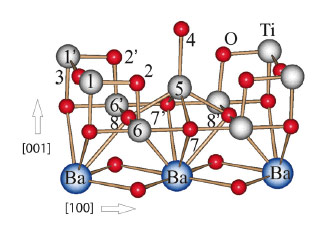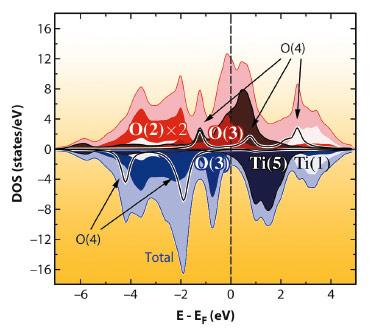- Home
- Users & Science
- Scientific Documentation
- ESRF Highlights
- ESRF Highlights 2012
- Structure of materials
- BaTiO3 (001) (2x1): Relation between structure and magnetism
BaTiO3 (001) (2x1): Relation between structure and magnetism
BaTiO3 (BTO) is an archetype ferroelectric whose physical properties have been well known for decades and have been thoroughly documented in solid state physics textbooks. Bulk BTO is a perovskite type ferroelectric (transition temperature TC = 408 K) insulator (bulk band gap = 3.2 eV). It is used in technological applications as a piezoceramic capacitor and in nonlinear optics. In contrast, nothing is known about the structure and physical properties of the surface of a BTO crystal, which has become a focus for research owing to possible applications in nanoscale oxide spintronic devices [1]. Although the (001) surfaces of STO and BTO are known to reconstruct to from a (2x1) and a (2x2) superstructure [2], a structure model exits only for STO [3]. We have carried out a combined surface X-ray diffraction (SXRD) and theoretical study of the atomic structure and the corresponding physical properties for BTO.
The SXRD experiments were carried out at beamline ID03 using a bulk crystal, which after mild Ar+ sputtering and annealing up to about 1000°C exhibits a (2x1) reconstruction with no traces of a (2x2) reconstruction.
The structure model is shown in Figure 110 in perspective side view. The BTO crystal is terminated by two stoichiometric TiO2 layers, similar to the STO(001) surface [3], but significant differences exist with respect to the position of the top layer structure. Here, the most important characteristic is that one titanium atom (5) resides in a fivefold coordination to oxygen atoms (7, 7’, 8, 8’ and 4) in the centre of a pyramid. In this way, the titanium atom (5) shifts inward thereby binding to oxygen atom (4) and to the second layer oxygen atoms at a distance of 2.30 ± 0.15 Å.
 |
|
Fig. 110: Model of the BaTiO3(001)-(2x1) structure in perspective side view. Two TiO2 layers (atoms #1-8) are located above the bulk-like BaO layer (primed labels correspond to symmetrically equivalent atoms). |
Based on this structure model the electronic and magnetic properties of the (2x1) BTO surface were calculated within the density functional theory (DFT) in the local density approximation using a Korringa-Kohn-Rostoker Green-function method, which is specially designed for semi-infinite layered systems. According to the DFT calculations, the BTO(001)-(2x1) surface is metallic and magnetic. Figure 111 shows the density of states (DOS) for spin up (↑) in red which is different from the spin down DOS (↓) shown in blue.
 |
|
Fig. 111: Spin resolved DOS of BTO(001)-(2x1). The contributions of the different atoms are indicated. Dark colour (red, blue) corresponds to Ti (5). The light (red) and blue profiles correspond to the total DOS. |
The DOS is large at the Fermi level (EF), this is related to the (↑) contribution of titanium atom (5) and oxygen atom (3). The filling of the titanium 3d states is mainly a consequence of the charge transfer from oxygen to titanium. Moreover, due to the low coordination and reduced symmetry, the different DOS contributions are narrow and involve partially unsaturated 2p states in the case the oxygen atoms (3) and (4). In turn this leads to high local magnetic moments up to 1.3 μB and -2.0 μB for the titanium atom (5) and oxygen atom (4), respectively.
In summary, our X-ray diffraction analysis of the BTO(001)-(2x1) reconstruction has identified an atomic arrangement that had not been considered before for (001) oriented perovskite surfaces. The most remarkable unit is a titanium atom in the centre of a tetragonal pyramid. This unique motif causes symmetry breaking, localisation of the electronic states, and charge transfer to the central titanium atom from surrounding oxygen atoms. This leads to metallisation and magnetisation which is now identified as an intrinsic property of the surface. We infer that this metallisation might also contribute to the stabilisation of the reconstruction related to the depolarisation of the surface.
Principal publication and authors
H.L. Meyerheim (a), A. Ernst (a), K. Mohseni (a), I.V. Maznichenko (b), S. Ostanin (a), F. Klimenta (a), N. Jedrecy (c), W. Feng (a), I. Mertig (a,b), R. Felici (d) and J. Kirschner (a,b), Phys. Rev. Lett. 108, 215502 (2012).
(a) Max-Planck-Institut f. Mikrostrukturphysik, Halle (Germany)
(b) Institut für Physik, Martin-Luther-Universität Halle-Wittenberg, Halle (Germany)
(c) Institut des NanoSciences de Paris, UPMC-Sorbonne Univ. CNRS-UMR7588, Paris (France)
(d) ESRF
References
[1] E.Y. Tsymbal and H. Kohlstedt, Science 313, 181 (2006).
[2] R. Courths, Phys. Stat. Solidi B 100, 135 (1980).
[3] R. Herger, P.R. Willmott, O. Bunk, C.M. Schlepütz, B.D. Patterson and B. Delley, Phys. Rev. Lett. 98, 076102 (2007).



